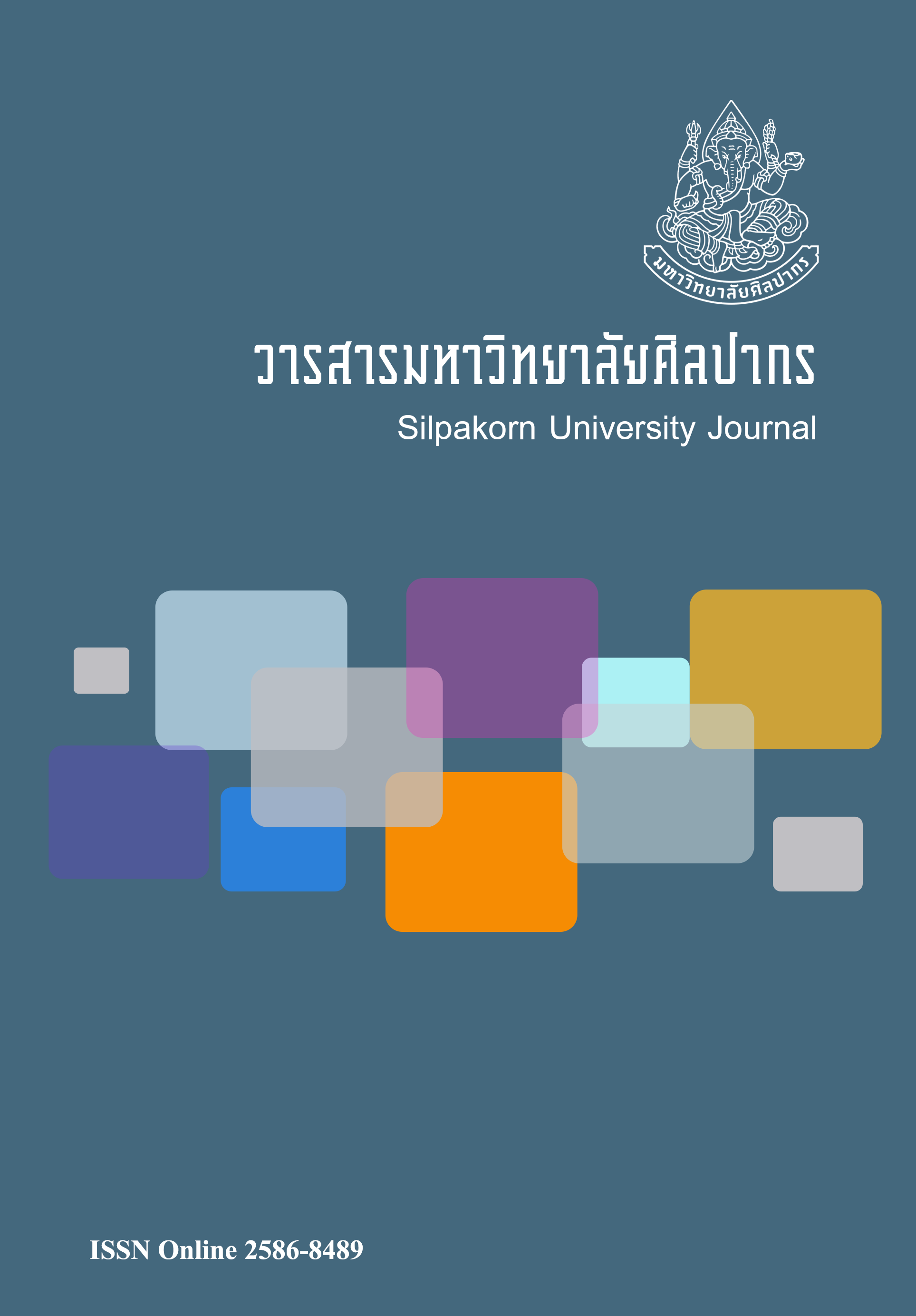การจัดการเรียนรู้โดยใช้ภาระงานเป็นฐาน : แนวคิดเพื่อการพัฒนาทักษะทางภาษาไทย (Task-Based Learning: An Approach for Thai Language Skills Development)
Main Article Content
Abstract
ภาษาไทยเป็นเครื่องมือที่ใช้ในการติดต่อสื่อสารของคนในชาติ เป็นมรดกทางวัฒนธรรมที่บรรพบุรุษได้สร้างสมมาให้แก่ชนรุ่นหลัง หลักสูตรแกนกลางการศึกษาขั้นพื้นฐาน พุทธศักราช 2551 ได้กำหนดให้กลุ่มสาระการเรียนรู้ภาษาไทยมี 5 สาระ ได้แก่ สาระที่ 1 การอ่าน สาระที่ 2 การเขียน สาระที่ 3 การฟัง การดู และการพูด สาระที่ 4 หลักการใช้ภาษาไทย และสาระที่ 5 วรรณคดีและวรรณกรรม ในจำนวนทั้ง 5 สาระนี้ สาระที่ 1 -3 นับเป็นสาระที่มุ่งเน้นทักษะการใช้ภาษาไทยของผู้เรียน ซึ่งมีความสำคัญและมีความจำเป็นอย่างมากที่ครูในฐานะผู้สอนและผู้ออกแบบกิจกรรมการเรียนรู้จะต้องจัดกิจกรรมการเรียนรู้เพื่อส่งเสริมและพัฒนาทักษะดังกล่าวให้แก่ผู้เรียน การนำแนวคิดมุ่งเน้นภาระงานหรือ Task based learning (Tbl) มาประยุกต์ใช้ในการจัดกิจกรรม การเรียนรู้เพื่อพัฒนาทักษะทางภาษาไทยนั้น นับว่าสอดคล้องกับหลักการพัฒนาทักษสัมพันธ์ เพราะแนวคิดมุ่งเน้นภาระงานหรือ Task based learning (Tbl) เป็นแนวคิดที่ให้ผู้เรียนได้ลงมือปฏิบัติกิจกรรมด้วยตัวเอง กระตุ้นทักษะทางการใช้ภาษาไทย ไม่ว่าจะเป็นการให้ผู้เรียนได้อ่าน เขียน ฟัง ดู และพูดเกี่ยวกับภาระงานที่ตนเองได้รับ เป็นการฝึกทักษะต่าง ๆ ไปพร้อมกัน ผู้เรียน มีโอกาสได้แลกเปลี่ยนเรียนรู้ แสดงความคิดเห็น ตลอดจนได้เป็นผู้เรียนรู้ด้วยตนเอง ครูเป็นเพียงผู้อำนวยความสะดวกให้แก่ผู้เรียนเท่านั้น ท้ายสุดผู้เรียนก็จะเรียนรู้อย่างมีเป้าหมายบรรลุวัตถุประสงค์ที่ตั้งไว้
The Thai language is a tool of communication of Thai people. It is cultural heritage of our ancestors which has been accumulated and transmitted to younger generations.The 2551 B.E. core curriculum for basic education specifies 5 strands of Thai language learning. The first one is reading, the second is writing, the third is listening, watching, and talking, the fourth is grammar and the last one is literature and literary works. Among the five strands, Strands 1-3 focus on students’ language skills. Thus it is very important and necessary for teachers, who are instructors and activity designers, to organize learning activities to promote and develop Thai language skills for students. Applying task-based learning in the organization of learning activities to develop Thai language skills is in accordance with the core Thai language textbook, “Taksasampan”. This is because task-based learning is the approach that allows students to do hands-on activities, stimulating their use of Thai language skills by reading, writing, watching and talking about the task they have been assigned to. It allows practicing all the skills simultaneously. Students have the opportunity to exchange knowledge, express ideas and become agents of their own learning. Teachers are only their facilitators. Eventually, students will learn how to achieve the target goals and objectives.
Article Details
References
Khuptikasem, W. (2016). The development of learning outcome on the topic, “leading consonant” and communication skill for the first grade student by using balanced literacy teaching. (การพัฒนาผลการเรียนรู้เรื่อง อักษรนำ และทักษะการสื่อสารของนักเรียนชั้นประถมศึกษาปีที่1 โดยใช้การสอนแนวสมดุลภาษา). Veridian E-Journal, 9(2) (May – August, 2017), 1128.
Limthrakan, S. (2004). The basic knowledge of reading (ความรู้เบื้องต้นเกี่ยวกับการอ่าน) (12th ed.). In the use Thai language unit 1-7. Nonthaburi: Sukhothai Thammathirat Open University.
Long, M. H. (1985). A role for instruction of second language acquisition: task-based language teaching. In K. Hyltenstam & M. Peinemann (Eds.). Modelling and assessing second language acquisition (pp. 77-99). Cleve don, England: Multilingual Matters.
Mansetthavit, S. (1994). The principles and methods of teaching Thai reading (หลักและวิธีสอนอ่านภาษาไทย). Bangkok: Thai Watana Panich Co., Ltd.
Moosikkharat, T. & Lumyotphol, T. (2008). The development a efficiency in reading (การพัฒนาสมรรถภาพในการอ่าน) (12th ed.). In the use Thai language units 9-15. Nonthaburi: Sukhothai Thammathirat Open University.
Nunan, D. (1989). Designing tasks for the communicative classroom. New York: Cambridge University.
Posakitsana, P. (1978). The important aspects of Thai language (ลักษณะสำคัญของภาษาไทย). Bangkok: The Secretariat of the cabinet.
Richards, J., Platt, J., & Weber, H. (1986). Longman dictionary of applied linguistics. London: Longman.
Sangphalasit, W. et al. (1976). The usage of language (การใช้ภาษา). Bangkok: Odeon Store.
Somprayoon, W. (2010). Thai language teaching techniques (เทคนิคการสอนภาษาไทย). Bangkok: dokyastore.
Tantiphacheeva, K. (2008). Instructional model for childhood (รูปแบบการเรียนการสอนปฐมวัยศึกษา). Bangkok: Brain-Based Book.
Vonvisit, K. (2008). Language skill for communication (ทักษะภาษาเพื่อการสื่อสาร). Bangkok: Odeon Store.
Willis, J. (1996). A framework for task-based learning. London: Longman.
Yuree, P. (2015). A study of creative writing ability of fifth grade students using the CIRC cooperative technique learning (การศึกษาความสามารถด้านการเขียนเชิงสร้างสรรค์ของนักเรียนชั้นประถมศึกษาปีที่ 5 ที่จัดการเรียนรู้แบบร่วมมือเทคนิค CIRC). Veridian E-Journal, 8(3) (September–December, 2017), 15.

